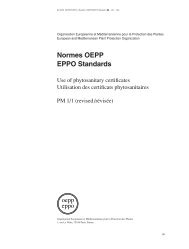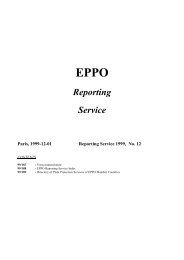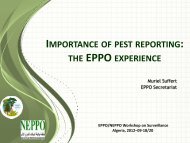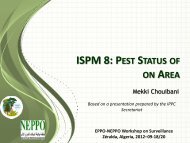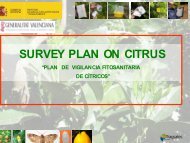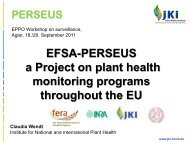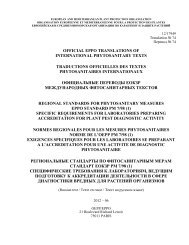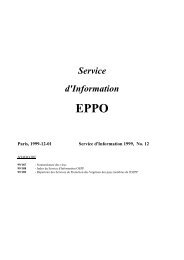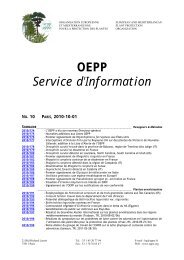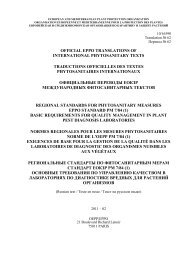EPPO Reporting Service - Lists of EPPO Standards - European and ...
EPPO Reporting Service - Lists of EPPO Standards - European and ...
EPPO Reporting Service - Lists of EPPO Standards - European and ...
Create successful ePaper yourself
Turn your PDF publications into a flip-book with our unique Google optimized e-Paper software.
<strong>EPPO</strong> <strong>Reporting</strong> <strong>Service</strong> – Pests & Diseases<br />
2011/026 First report <strong>of</strong> Phytophthora lateralis in the United Kingdom<br />
The NPPO <strong>of</strong> the United Kindgom recently informed the <strong>EPPO</strong> Secretariat <strong>of</strong> the first record<br />
<strong>of</strong> Phytophthora lateralis (<strong>EPPO</strong> A1 List) in Scotl<strong>and</strong>. In October 2010, dieback <strong>and</strong><br />
mortality <strong>of</strong> Chamaecyparis lawsoniana trees was noticed at the Balloch Castle Country<br />
Park. This park is an important historical site located within the Loch Lomond <strong>and</strong><br />
Trossachs National Park. Affected trees were predominantly mature (approximately 70-80<br />
year old) <strong>and</strong> showed symptoms which varied from foliage dieback <strong>of</strong> discrete patches <strong>of</strong><br />
the crown to mortality. Some <strong>of</strong> the declining Chamaecyparis trees were also showing resin<br />
bleeding on the stems <strong>and</strong> branches, which apparently originated at branch junctions or<br />
wounds. Root <strong>and</strong> stem samples were taken from 4 trees <strong>and</strong> tested. Laboratory tests<br />
(lateral flow device for Phytophthora spp., PCR <strong>and</strong> sequencing, morphology) confirmed<br />
the presence <strong>of</strong> P. lateralis.<br />
During winter, further investigations on the site were hampered by bad weather conditions<br />
(heavy snow). However, by February 2011 a total <strong>of</strong> 90 symptomatic, including 10<br />
confirmed positively by laboratory tests, infected C. lawsoniana had been identified <strong>and</strong><br />
these were all felled <strong>and</strong> destroyed by burning by 23 February. A single C. lawsoniana was<br />
confirmed as infected by P. ramorum (<strong>EPPO</strong> Alert List), only the second specimen <strong>of</strong> this<br />
species found infected with P. ramorum in the UK. A Rhododendron plant was found<br />
positive for P. ramorum <strong>and</strong> has been destroyed. P. cinnamomi was also found infecting<br />
Taxus baccata on the site. These infected plants have also been voluntarily destroyed.<br />
Investigations are continuing at the site <strong>and</strong> surveys <strong>of</strong> all C. lawsoniana within 3 km <strong>of</strong> the<br />
park will be carried out in the spring, in order to determine future management measures.<br />
For the moment, it has not been possible to identify the source <strong>of</strong> introduction <strong>of</strong> P.<br />
lateralis into Scotl<strong>and</strong> but it is suspected that the pathogen may have been present in this<br />
park for 5 to 10 years. Precautions are being taken to prevent any further spread <strong>of</strong> the<br />
pathogen (i.e. prohibition to move plant material from the infected site including<br />
composted material, disinfection <strong>of</strong> all machinery <strong>and</strong> equipment used for tree<br />
destruction, warning notices for visitors <strong>and</strong> disinfectant foot mats at all exit points <strong>of</strong> the<br />
park).<br />
The pest status <strong>of</strong> Phytophthora lateralis in the United Kingdom is <strong>of</strong>ficially declared as:<br />
Present, under eradication.<br />
Source: NPPO <strong>of</strong> the United Kingdom (2011-03).<br />
Additional key words: new record Computer codes: PHYTLA, GB<br />
2011/027 First report <strong>of</strong> Phytophthora lateralis in Taiwan<br />
Studies were conducted in Taiwanese forests to detect the presence <strong>of</strong> unknown<br />
Phytophthora species or invasive species such as P. ramorum (<strong>EPPO</strong> Alert List) or P.<br />
lateralis (<strong>EPPO</strong> A1 List). In 2008, soil samples were collected in an old cypress st<strong>and</strong><br />
(Chamaecyparis obtusa var. formosana) in the Ma-Kau ecological park in North-Eastern<br />
Taiwan. Collected samples were subject to Phytophthora baiting procedures at 18°C.<br />
Several isolates <strong>of</strong> Phytophthora lateralis were identified in one soil sample which had<br />
been obtained from water running through a cedar st<strong>and</strong>. This is the first time that P.<br />
lateralis is recorded from Taiwan. It is hypothetized that Asia (in particular Japan, Taiwan<br />
<strong>and</strong> Yunnan) is the area <strong>of</strong> origin for P. lateralis. The authors concluded that further<br />
surveys <strong>of</strong> P. lateralis in Taiwanese Chamaecyparis st<strong>and</strong>s are needed, as well as<br />
comparative studies between isolates from different continents (Asia, Europe <strong>and</strong> North<br />
America).<br />
2




